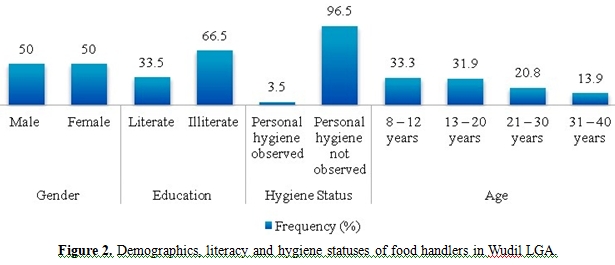Microbiological safety assessment of food handlers in Wudil Local Government Area of Kano State, Nigeria
Abstract
This study was conducted to investigate the bacteriological safety levels of food handlers in Wudil Local Government Area (LGA) of Kano State, Nigeria. A total of 200 hand-swab samples were collected from different male [100 (50%)] and female [100 (50%)] food handlers/peddlers in the study area. From these samples, 200 non-duplicate bacterial isolates consisting of strains of Salmonella typhi [60 (30%)], Salmonella choleraesuis [52 (26%)], Proteus mirabilis [10 (5%)], Morganella morganii [10 (5%)], Pseudomonas aeruginosa [10 (5%)], Escherichia coli [18 (9%)] and Staphylococcus aureus [40 (20%)] were isolated. A significant proportion (33.3%) of the food handlers sampled was children within the age range of 8-12 years. In addition, only 33.5% of the food handlers had basic level of primary education and a majority (96.5%) of the food handlers displayed poor levels of personal hygiene, especially with regards to safe food handling. S. typhi, S. cholaeresius and S. aureus were found to be the common bacterial species that colonized the hands of food handlers/peddlers in Wudil LGA, Kano State. This highlights a lack of food safety and the resulting risk of spreading foodborne diseases in the area. In addition, low literacy levels and lack of safe food handling practices contribute to the prevalence of these pathogens among the food handlers. It is important for food handlers to obtain training on safe food practices, undergo periodic health checks and practice proper hand hygiene.
References
2. WHO. Food safety. World Health Organization, Geneva. https://www.who.int/news-room/fact-sheets/detail/food-safety. 2019.
3. Mead PS, Slutsker L, Dietz V, McCaig LF, Bresee JS, Shapiro C, et al. Food-related illness and death inthe United States. Emerg Infect Dis. 1999; 5: 607-625.
4. Baylis C, Uyttendaele M, Joosten H, Davies A. Enterobacteriaceae and their significance to the food industry. ILSI Europe Report Series. 2011: 1-48.
5. Zaglool DA, Khodari YA, Othman RA, Farooq MU. Prevalence of intestinal parasites and bacteria among food handlers in a tertiary care hospital. Niger Med J. 2011; 52(4): 266-270.
6. Andargie G, Kassu A, Moges F, Tiruneh M, Huruy K. Prevalence of bacteria and intestinal parasites among food-handlers in Gondar town, northwest Ethiopia. J Health Popul Nutr. 2008; 26(4): 451-455.
7. Schlundt J, Toyofuku H, Jansen I, Herbst SA. Emerging food‑borne zoonoses. Rev Sci Tech. 2004; 23: 513‑533.
8. Nkere CK, Ibe NI, Iroegbu CU. Bacteriological quality of foods and water sold by vendors and in restaurants in Nsukka, Enugu State, Nigeria: a comparative study of three microbiological methods. J Health Popul Nutr. 2011; 29(6): 560-566.
9. Smith SI, Agomo CO, Bamidele M, Opere BO, Aboaba OO. Survey of food handlers in bukas (a type of local restaurant) in Lagos, Nigeria about typhoid fever. 2010; 2(8): 951-956.
10. Ifeadike CO, Ironkwe OC, Adogu PO, Nnebue CC. Assessment of the food hygiene practices of food handlers in the Federal Capital Territory of Nigeria. Trop J Med Res. 2014; 17: 10-15.
11. Ezirigwe J. Much ado about food safety regulation in Nigeria. J Sustain Develop Law Policy. 2018; 9(1): 109-132.
12. Google Maps. https://www.google.com/maps/@11.8022931,8.8394038,15z [Date accessed: April 09, 2020].
13. National Population Commission. Federal Republic of Nigeria 2006 Population and Housing Census. Priority Table Volume IV. Population distribution by age & sex (State & Local Government Area). National Population Commission, Abuja, Nigeria 2010.
14. Cheesbrough, M. District laboratory practice in tropical countries. 2nd edn, part 2. Cambridge University Press. 2000: 62-70.
15. Mølbak K, Olsen JE, Wegener HC. Salmonella infections. In: Foodborne infections and intoxications. Elsevier Inc. 2006.
16. FAO. Assuring food safety and quality: Guidelines for strengthening national food control systems. Food and Agriculture Organization of the United Nations (FAO) food and nutrition paper. 2003: 254-4725.
17. Mohan U, Mohan V, Raj KA. Study of carrier state of S. Typhi, Intestinal parasites & personal hygiene amongst food handlers in Amritsar City. Indian J Commun Med. 2006; 31: 60-61.




